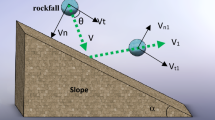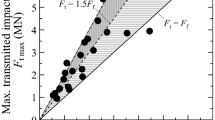Abstract
Gravel cushions are widely laid on the top of structures or rock sheds to absorb the impact energy of rockfalls in mountainous districts. Based on the discrete element method, a numerical model of a rockfall impacting a 2D mixed-size gravel cushion layer at an initial angular velocity was established in this study. The penetration depth of the rockfall, impact force of the cushion surface, and energy dissipation ratio were investigated. Increasing the initial angular velocity and decreasing the particle size of the cushion were found to evidently reduce the maximum penetration depth of the rockfall and increase the impact force of the cushion surface, respectively. The energy dissipation ratio after collision was affected by the particle size of the cushion and the ratio of the angular kinetic energy. Omitting the initial angular velocity led to an underestimation of the energy dissipation ratio, by up to 40.8%. With decreasing particle size of the cushion, the energy dissipation ratio first increased but then decreased. The study results provide a theoretical basis for the design of gravel cushions intended for rockfall protection.












Similar content being viewed by others
References
Wang, X., Frattini, P., Stead, D., et al.: Dynamic rockfall risk analysis.Engineering Geology, :105622. (2020)
Mineo, S.: Comparing rockfall hazard and risk assessment procedures along roads for different planning purposes. J. Mt. Sci. 17(3), 653–669 (2020)
Wang, M., Shi, S.Q., Liu, Y.F., et al.: Energy Consumption Performance Analysis and Optimum Design of Falling Stone Flexible Shelter Cave. Vib. shock. 37(1), 216–222 (2018)
He, S.M.: Calculation of impact pressure of rockfall on protective structure. Eng. Mech. 27(09), 175–180 (2010)
Singh, A.K., Kundu, J., Sarkar, K., Verma, H.K., Singh, P.K.: Impact of rock block characteristics on rockfall hazard and its implications for rockfall protection strategies along himalayan highways: a case study. Bull. Eng. Geol. Environ. 80(7), 5347–5368 (2021)
Bourrier, F., Nicot, F., Darve, F.: Physical processes within a 2D granular layer during an impact.Granular Matter, 10(6). (2008)
Lambert, S., Bourrier, F.: Design of rockfall protection embankments: a review. Eng. Geol. 154, 77–88 (2013)
Nakajima, S., Abe, K., Shinoda, M., Nakamura, S., Nakamura, H.: Experimental study on impact force due to collision of rockfall and sliding soil mass caused by seismic slope failure.Landslides, (2020)
Wang, Y.S., Xu, M., Yang, C., Lu, M.Y., et al.: Effects of elastoplastic strengthening of gravel soil on rockfall impact force and penetration depth.International Journal of Impact Engineering, (2020). 136(C).
Breugnot, A., Lambert, S., Villard, P., Gotteland, P.: A discrete/continuous coupled approach for modeling impacts on cellular geostructures. Rock. Mech. Rock. Eng. 49(5), 1831–1848 (2016)
Second Design Institute of the Ministry of Railways: Technical Manual for Railway Engineering Design. Tunnels, People’s Railway Publishing House, Beijing, China (1978)
Kawahara, S., Muro, T.: Effects of dry density and thickness of sandy soil on impact response due to rockfall. J. Terrramech. 43(3), 329–340 (2006)
Cui, S.H., Pei, X.J., Huang, R.Q.: Rolling motion behavior of rockfall on gentle slope: an experimental approach. J. Mt. Sci. 14(8), 1550–1562 (2017)
Wei, X.R., Duan, S.Z., Sun, J.L., et al.: Particle velocity prediction of rockfall on slope based on collision model. J. Mech. 52(03), 707–715 (2020)
Beladjine, D., Ammi, M., Oger, L., et al.: Collision process between an impact bead and a three-dimensional granular packing. Phys. Rev. E Stat. Nonlinear Soft Matter Phys. 75(6), 061305 (2007)
Ji, Z.M., Chen, Z.J., Niu, Q.H., Wang, T.J., Song, H., Wang, T.H.: Laboratory study on the influencing factors and their control for the coefficient of restitution during rockfall impacts.Landslides, (2019)
Zhu, C., Wang, D.S., Xia, X., et al.: The effects of gravel cushion particle size and thickness on the coefficient of restitution in rockfall impacts. Nat. Hazards Earth Syst. Sci. 18(6), 1811–1823 (2018)
Li, L.P., Sun, S.Q., Li, S., et al.: Coefficient of restitution and kinetic energy loss of rockfall impacts. KSCE J. Civ. Eng. 20(6), 2297–2307 (2016)
Tang, J., Zhou, X., Liang, K., et al.: Experimental study on the coefficient of restitution for the rotational sphere rockfall. Environ. Earth Sci. 80(11), 1–18 (2021)
Liu, G.Y., Li, J.J.: A three-dimensional discontinuous deformation analysis method for investigating the effect of slope geometrical characteristics on rockfall behavior. Int. J. Comput. Methods. 16(8), 1850122 (2019)
Shen, W., Zhao, T., Dai, F.: Influence of particle size on the buffering efficiency of soil cushion layer against rockfall impact.Natural Hazards, :1–20. (2021)
Zhang, L., Lambert, S., Nicot, F.: Discrete dynamic modelling of the mechanical behaviour of a granular soil. Int. J. Impact Eng. 103, 76–89 (2017)
Gao, G., Meguid, M.A.: On the role of sphericity of falling rock clusters—insights from experimental and numerical investigations. Landslides. 15(2), 219–232 (2018)
Gao, G., Meguid, M.A., Chouinard, L.E., et al.: Dynamic disintegration processes accompanying transport of an earthquake-induced landslide. Landslides. 18(3), 909–933 (2020)
Shen, W., Zhao, T., Dai, F., et al.: DEM analyses of rock block shape effect on the response of rockfall impact against a soil buffering layer. Eng. Geol. 249, 60–70 (2019)
Su, Y., Cui, Y., Ng, C., et al.: Effects of particle size and cushioning thickness on the performance of rock-filled gabions used in protection against boulder impact. Can. Geotech. J. 56(2), 198–207 (2019)
Naito, N., Maeda, K., Konno, H., et al.: Rockfall Impacts on sand Cushions with Different soil Mechanical Characteristics Using Discrete Element Method. Soils and Foundations (2020)
Ye, X.Y., Wang, D.M., Zheng, X.J.: Influence of particle rotation on the oblique penetration in granular media.Physical Review E, 86(6). (2012)
Ye, X.Y., Wang, D.M., Zheng, X.J.: Criticality of post-impact motions of a projectile obliquely impacting a granular medium. Powder Technol. 301, 1044–1053 (2016)
Takizawa, S., Katsuragi, H.: Scaling laws for the oblique impact cratering on an inclined granular surface.Icarus,113409. (2019)
Takizawa, S., Yamaguchi, R., Katsuragi, H.: A novel experimental setup for an oblique impact onto an inclined granular layer. Rev. Sci. Instrum. 91, 014501 (2020)
Zhang, S.L., Yang, X.G., Zhou, J.W.: A theoretical model for the estimation of maximum impact force from a rockfall based on contact theory. J. Mt. Sci. 15(002), 430–443 (2018)
Guzzetti, F., Crosta, G., Detti, R., Agliardi, F.: STONE: a computer program for the three dimensional simulation of rock-falls. Com-put Geosci. 28, 1079–1093 (2002)
Masanori, K., Akito, T., Katsuya, K., et al.: Laboratory Experiment and Numerical Analysis of rockfall impacts. J. Soc. Mater. ence Japan. 65(5), 377–383 (2016)
Acknowledgements
This study was supported by the National Natural Science Foundation of China (Grant No. 12262021), Doctor Funding of Lanzhou University of Technology (Grant No. 04–061407). The authors would like to express their sincere appreciation to these supports.
Author information
Authors and Affiliations
Corresponding author
Ethics declarations
Conflict of interest
The authors declare that they have no known competing financial interests or personal relationships that could have appeared to influence the work reported in this paper.
Additional information
Publisher’s Note
Springer Nature remains neutral with regard to jurisdictional claims in published maps and institutional affiliations.
Rights and permissions
Springer Nature or its licensor (e.g. a society or other partner) holds exclusive rights to this article under a publishing agreement with the author(s) or other rightsholder(s); author self-archiving of the accepted manuscript version of this article is solely governed by the terms of such publishing agreement and applicable law.
About this article
Cite this article
Duan, S., Yu, H. & Xu, B. Numerical simulation of a rockfall impacting a gravel cushion with varying initial angular velocity and particle sizes. Granular Matter 25, 33 (2023). https://doi.org/10.1007/s10035-023-01320-3
Received:
Accepted:
Published:
DOI: https://doi.org/10.1007/s10035-023-01320-3




